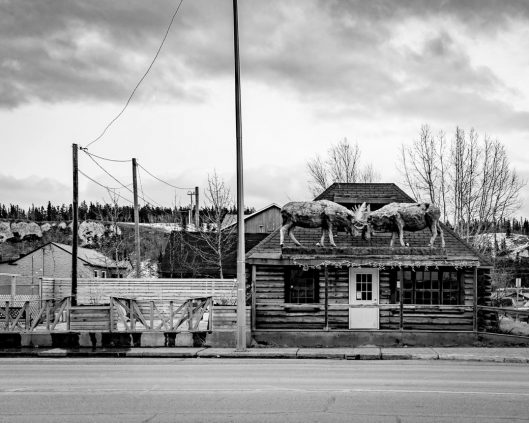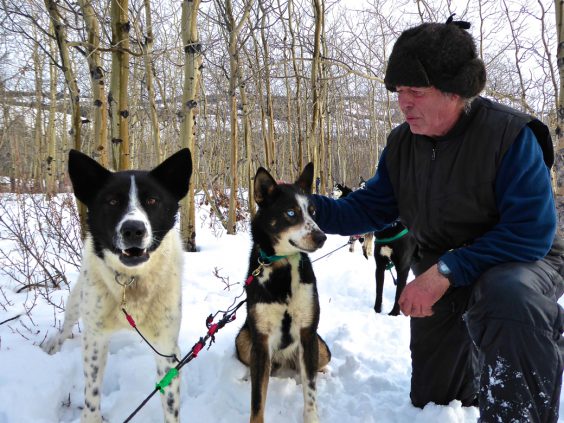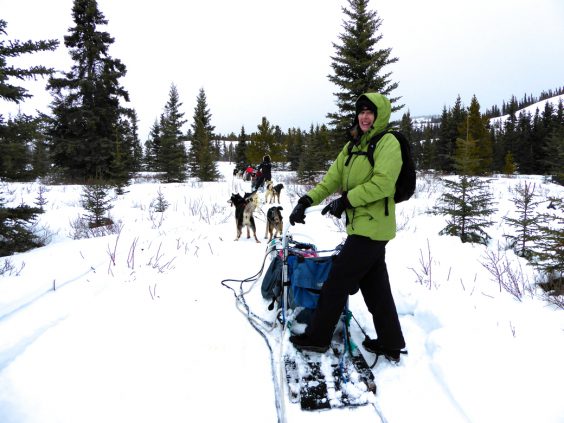If you’re a cold-weather adventurer, perhaps, like me, you’ve longed to visit the North in the deepest, darkest days of winter.
I’ve dreamed of seeing the fantastical snap, crackle and pop of the Aurora Borealis, of dogsledding across a frozen lake, of tossing a cup of boiling water into the bone-chilling air and watching it vaporize before hitting the ground. (I’ve seen the pictures.)
When I finally get a chance to visit Whitehorse with a small group of travel media at the end of February in 2016, I step off the pleasant 2 1/2-hour Air North flight from Calgary sweating in my down-filled mukluks, and find that it is … unseasonably mild?
The weather is the first of several surprises that Yukon’s capital city and surrounding area serve up during my visit. Some of these surprises challenge the stereotypes held by southerners; most surpass the notions of an incurable romantic.

Whitehorse, Yukon / Photo by Valerie Berenyi
Embracing the elements
Winter in Whitehorse is typically milder than most of the North, but it can get some wicked cold snaps. In fact, Yukon boasts the coldest temperature ever officially recorded in North America: minus 63° at the village of Snag, about 450 km northwest of Whitehorse, in February 1947.
When I visit, temperatures in the city hover around zero and drop to minus 15 at night. (This winter, however, they’re forecasting normal to below normal temperatures in Whitehorse, with average temperatures reaching minus 13 during the day and minus 18 at night.)
Still, while there is no hot water tossing event for me, my Southern buns freeze whenever the wind blows in and clouds scud over the winter sun. It’s best to bring multiple layers, a couple of neck tubes and extra wool socks. If you don’t have the right outerwear, you can rent it from MW Outfits; order in advance and they’ll have a duffle bag of gear conveniently waiting for you at your hotel.
Locals here, like Tom Thurmer, embrace the elements. A transplanted German who’s lived in Whitehorse for nearly 30 years, he was captivated by the romance of the Yukon after “I read too many Jack London stories when I was a kid.” Joining the throngs of German tourists, he visited in 1980, returned six times, then stayed for good.
Thurmer revels in the remoteness, the wilderness, the laid-back, inexpensive lifestyle supplemented by hunting and fishing. Like many Yukoners, he cobbles together a living; he rents a cabin, works as a personal guide for visiting adventurers and serves as a guide and driver for Northern Tales Travel Services, the tour company that ferries us from Whitehorse on some of our wilderness adventures.
Pockets of cool
Nicknamed Wilderness City, you might expect to see dudes in buckskin roaming the streets here.
There is a classic main street with several Klondike-style buildings, but mostly this is a low-rise, contemporary and compact city of almost 26,000 people tucked into a protected valley along the shores of the famed Yukon River.
Whitehorse — named for nearby river rapids that once conjured up images of the mane of a white horse — runs on tourism, arts and culture, three levels of government and mining; it’s the full-service centre of Yukon, a vast territory with almost 36,000 residents.
The Westmark Whitehorse Hotel is our base camp, a two-storey building that is walking distance to everything. (I fit right in at the hotel’s bar, sipping a Yukon Gold in my pilled fleece.)
From the hotel, I explore the town’s pockets of cool, where new life has been injected into funky old buildings: there’s Burnt Toast Cafe for rustic-chic bistro fare, including a killer grilled cheese on sourdough; Baked Cafe & Bakery for vegan pastries; and Woodcutter’s Blanket for classic cocktails where you can savour a Rum Flip in a lovingly renovated 1930s-era log cabin.

Woodcutter’s Blanket, Whitehorse / Photo courtesy James Maltby
I dine like a northern queen on guacamole-encrusted salmon with sweet potatoes at Antoinette’s Restaurant, which infuses a dash of the Caribbean into its international fare.
Mad for mushing
We travel 50 kilometres north of Whitehorse to the cold and snow of Lake Laberge — a long, frozen wind-swept body of water (which is actually a widening of the Yukon River) immortalized by Robert Service in his poem “The Cremation of Sam McGee.”
Ned Cathers of Cathers Wilderness Adventures meets us on the west shore with three teams of sled dogs and his snowmobile.
A veteran musher who raced in the 1,000-mile Yukon Quest 10 times, he and his family live across Lake Laberge on 20 secluded acres accessible only by dog sled, snowmobile or boat.

Photo by Valerie Berenyi
Over the ear-splitting barking of 18 dogs, Cathers asks our group of greenhorns who’d like to drive her own sled; I immediately say yes. I’d tried dog mushing once before, but never by myself.
“Don’t leave the sled until we’re tied up again,” the gentle Cathers cautions me as he unhitches my team of six impatient canine athletes, all clamouring Let’s go, let’s go, let’s go! I grip the sled’s handle bar, put all my weight on the claw brake, then gingerly step onto the rubber footboards atop the runners. And we’re off!

Photo courtesy Valerie Berenyi
Crossing Lake Laberge is exhilarating. The dogs are quiet now, intent on their work. They grab bites of snow while on the fly. The commands — “okay” (go), “whoa” (stop), “gee” (right) and “haw” (left) — are really just suggestions, says Cathers. The dogs thrive on encouragement. He whistles to them as he snowmobiles alongside us. My lips are too cold to whistle but I call out praise: “Good dogs!”
Nine kilometres later, we arrive near the homestead where Cathers settled 34 years ago after a move from Ontario. He expertly builds a small fire and soon we are winter picnicking in a sunny hollow in the trees, roasting wieners and drinking hot apple cider.
After lunch, we hug up the dogs — most are pussycats, really — snoozing in their harnesses (and firmly tied up). One line of dogs is named for chimney sweeps, Ash, Smoke and Carbon; another for musical instruments, Oboe, Piccolo and Fiddle.
Cathers and his adult daughter Jeninne, who holds the record for being the youngest person at age 18 to finish the Yukon Quest in 1989, operate year round with about 65 dogs, offering canoeing, cabin rentals and hiking with pack dogs in summer.
People typically stay with the wilderness operation a week at a time. Some, like one Swiss guest who’s returned for the past 26 years to spend six weeks in winter, are mad for mushing. I understand the attraction.
Iron dog adventures
The next day, it’s snowing. Fat flakes pelt us as I clutch the snowmobile’s rear handgrips riding as Scott McDougall’s passenger. A wide grin is pasted on my face; I’ve never traveled quite like this before.
We head out on tracks from Haines Junction, a tiny village located 154 km north of Whitehorse on the Alaska Highway, smack up against Kluane National Park and Reserve.
McDougall — who owns Kanoe People Ltd and Fox Bay Retreat on Lake Laberge — leads our small group of newbie sledders past driveways, houses, through bush and up a mountainside to a viewpoint. “Believe it or not,” he says with a laugh when we arrive, “there are mountains behind those clouds.”

Photo by Valerie Berenyi
Majestic Kluane is home to some of the tallest mountains in North America, including Mount Logan. At 19,545 feet (5,959 metres), it’s the highest mountain in Canada and the second highest peak on the continent after Denali in Alaska.
We happily opt for a hot tea break with cookies that McDougall generously brought for the outing.
He’s another migrant, a small-town Saskatchewan boy who drove North in a beat-up old pickup truck in the mid-1970s, seeking adventure and finding his place in the Yukon.
“There’s freedom to be who you want to be,” says the wilderness outfitter and guide, whose enthusiasm for the territory is infectious. “People don’t judge you here, they embrace you; they embrace variety.”
Up, up and away
I get a second chance to see Kluane later that afternoon when there’s a break in the weather. We scramble to Haines Junction Airport and board pilot John Ostashek’s Cessna 206 for an unforgettable hour of “flight-seeing.”

Photo courtesy Valerie Berenyi
Bouncing down the runway on round tires, Ostashek, co-owner of Rocking Star Adventures quickly pops the five-seat plane up and away.
Soon, a vast panorama of mountains clad in snow unfolds below, with great rivers of ice and rubble winding inexorably between ranges. Glaciers!
Words escape me. All I can think is that in the face of climate change it is truly comforting — cold comfort of the utmost Canadian kind — to witness the stunning beauty of this icy empire.
Long may it reign.

Photo by Valerie Berenyi
Pure Canadiana
It’s my last night in town. Fingers and toes are crossed for a good showing of the Aurora Borealis. At 10 pm a shuttle van from Northern Tales Travel Services picks us up at the Westward and whisks us 30 minutes out of town to the bush where light pollution won’t spoil the view.
Two trapper’s cabins, walled tents really, glow at the edge of a huge farmer’s field where guides patiently help us set up our cameras to shoot the Northern Lights.
There are lots of photographers out tonight, including Christy Woodrow who took the photo below. Stars, too, gleaming coldly amidst the clouds that we pray the wind will tear away.
Excitement builds as a ghostly green glow appears in the north sky. Time-release shutters reveal more colours than the naked eye can see.

Photo by Christy Woodrow / www.ordinarytraveler.com
Then the clouds drift back, so we head into the cabins for snacks, coffee and hot chocolate, to warm ourselves or doze by the wood-fired barrel stoves.
Outside, a campfire illuminates a small circle of folks who talk quietly.
Like the clouds, we drift in and out — practising our night photography, painting outlines with flashes, waiting patiently. Minutes stretch into hours but it feels timeless.
At 2:30 am it is time to go and even though the really big show never fully materializes, the experience is pure northern Canadiana.
Like so many others who dream of chasing the elusive Northern Lights, I leave wanting to return, again and again.
*Editor’s note: Thanks to our friends at Travel Yukon (who did not edit or review this story before publication) for hosting our writer. Thanks also to photographer Dave Brosha for his gorgeous aerial shot of Kluane National Park & Reserve. For more stories by T&C senior editor and contributor Valerie Berenyi, check out Puss’n (hiking)boots, Cold Land, Warm Heart, and Hotel Arts: The smart hipster’s sexy new hangout.
Founded by two Canucks on the loose in a big country, Toque & Canoe is a blog about Canadian travel culture.

